A surge protector is like your own private Secret Service detail. It stands guard, silent, sleepless, ready to lay down its life for the good of many. It’s the hallowed gatekeeper for your RV electrical system.
Most RVers own a surge protector. Everyone should.
If you don’t have a surge protector yet, or you’re not sure when to use one, then keep reading. The next five minutes might save you a few thousand dollars, and maybe even your life.
You’re about to drink from the fire hose of surge protector information, so get prepared!
In this article, you’ll learn everything you need to know about RV surge protectors and energy management systems (EMS). Bottoms up!
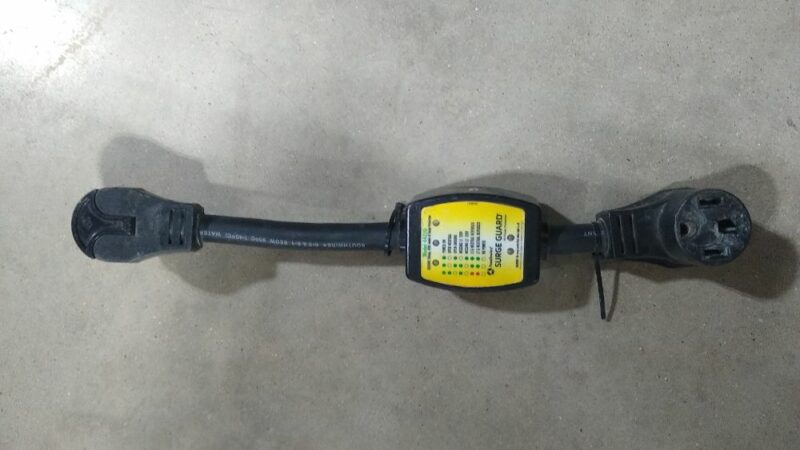
Surge Protector Info at a Glance (TL;DR)
A surge protector shields your camper’s electrical system and electronic components from damage and danger caused by voltage surges and drops.
Voltage fluctuations can be caused by lightning storms, broken power lines, or large switching loads. It’s an all-too-common problem at older campground sites.
An EMS (Energy Management System) is a more advanced version of a surge protector that can also detect other electrical problems that could cause damage. “EMS” was originally coined by Progressive Industries, but it’s now become the eponym for similar products.
You should really get an EMS. They are well worth the extra cost.
Both units are available as portable plug-in and hardwired products.
- Hardwired units are permanently installed within your RV.
- Portable units are connected between your power pedestal and RV power inlet.
Prices range from $50 for a simple plug-in voltage surge guard to $400 for an all-in-one 50A 120/250V EMS with fancy-schmancy features like a Bluetooth connection and LCD screen.
The average price for an EMS guard is about $200-$300. That’s a lot less than the cost of a replacement refrigerator!
Without a surge protector, high or low voltages could start an RV fire or irreparably damage control boards in your microwave, air conditioner, and other appliances.
IMHO, you need an EMS surge protector. You should use one every time you plug into shore power. They can prevent thousands of dollars worth of damage to your camper’s electrical system.
If you’re short on time and don’t make it to the end of this article, here are my recommendations for the best 30A and 50A RV surge protectors. I think portable units are best for most RVers, so those are the two I’m recommending.
Best 30A Portable Surge Protectors (EMS) for RVs
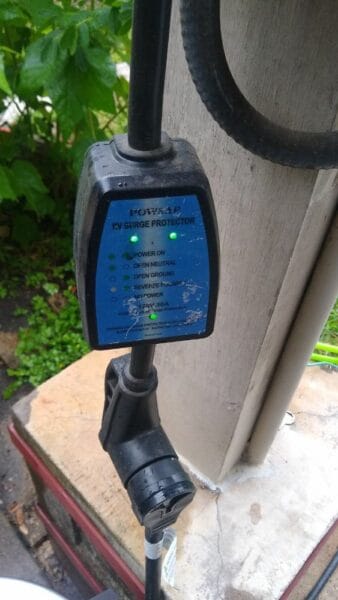
Portable RV Surge Protector EMS-PT30X
The EMS PT30X is the industry-leading surge protector for RVs. It includes under/under voltage protection, accidental 240V protection, and a bypass switch. Comes with a built-in LCD screen.
Progressive Dynamics PT30/50X Instruction Manual
Southwire Surge Guard 30A
Boasting 2450 Joules of protection for 30-amp 120V systems, the Southwire 34930 EMS surge protector offers under/over voltage protection, accidental 240V protection, and a convenient easy-pull handle. Has LCD screen and optional Bluetooth.
Southwire 34930/34950 Instruction Manual
Hughes PWD30-EPO
Famed for its replaceable surge module, the Hughes 30A EMS boasts 2400 Joules of surge protection, a Kilowatt power monitor, a free smart device app, and a host of other electrical indicators and protections. Highly rated!
Hughes PWD30-EPO Instruction Manual
Best 50A Portable Surge Protectors (EMS) for RV

If your rig runs on 50-amp service, then these portable 50A surge protectors are the top two I recommend.
If you’re a full-timer, you may also consider a hardwired model (discussed throughout the article and recommendations shown at the end).
Portable RV Surge Protector EMS-PT50X
The EMS PT50X is the industry-leading surge protector for larger RVs. It includes under/under voltage protection, frequency protection, and a bypass switch. Comes with a built-in LCD screen.
Progressive Dynamics PT30/50X Instruction Manual
Southwire Surge Guard 50A
Boasting 4200 Joules of protection, the Southwire 34950 EMS surge protector offers under/over voltage protection, frequency protection, and a convenient easy-pull handle. Comes with a built-in LCD screen and optional Bluetooth connectivity.
Southwire 34930/34950 Instruction Manual
Hughes PWD50-EPO
Famed for its replaceable surge module, the Hughes 50A EMS boasts 4800 Joules of surge protection, a Kilowatt power monitor, a free smart device app, and a host of other electrical indicators and protections. Highly rated!
Hughes PWD50-EPO Instruction Manual
How Do I Purchase an RV Surge Protector?
You can either purchase a hardwired unit or a portable surge protector.
Using a portable surge protector is simple.
- You plug your camper power cord into the surge protector.
- You plug the surge protector into your campsite power pedestal.
- You continue life as normal.
In normal operation, using a surge protector should have no impact on your RV.
Yes, you can use a surge protector with an adapter.
Check your Owner’s Manual for details, but most surge protectors are rated for down to 15A at 120V. That means you can plug them into a simple household outlet, and they’ll still detect electrical problems.
EMS Vs Surge Protector
A surge protector, as we’ve discussed, is a sacrificial component that protects your electric system from voltage spikes and surges.
An EMS is like a surge protector on steroids, and it’s what I highly, HIGHLY recommend.
In this article, unless I contrast or compare, I generally use the phrase “surge protector” to refer to both a basic protector and an EMS.
An EMS can detect and even shield against the following out-of-bound electrical conditions:
- High voltage (above 132 volts)
- Low voltage (brownouts) (below 104 volts)
- Open neutral
- 120V system: Energized, shock hazard, open circuit
- 240V system: Energized, 240V applied to 120V circuits! DANGER
- Open hot (no power)
- Reverse polarity (miswired pedestal or subpanel)
- Open ground (shock hazard)
- High frequency (above 62.5 Hz)
- Low frequency (below 57 Hz)
- High current (excess of circuit rated amperage)
These advanced units are called Energy Management Systems (EMS), a phrase first coined by Progressive Industries. It’s become an eponym for similar products.
Did I mention I highly advise an EMS over a basic surge protection system?!
It’s more common than you think to have a power pedestal wired backward, low voltage at the pedestal, or a miswired connection sending 220V power charging through a 120V system.
These all-in-one solutions not just protect your belongings but also yourself. An RV fire is no laughing matter. People die. Entire campgrounds get burned to the ground. Protect yourself and those around you.
Hey, how about those outlet testers?
I’d like to make a quick note about an outlet tester. Some well-meaning RV owners take the cheap way out. They test the power pedestal with A) a multimeter or B) a 15A-to-30A pigtail adapter and a simple outlet tester like this 120V outlet tester from Sperry Instruments.
Now, I highly recommend an outlet tester – but for your outlets! Not to guard against the supply power! Two reasons why:
- Most testers won’t detect out-of-bound voltage rise and drop.
- A tester only measures the conditions at a single point in time. It does nothing to measure, detect, warn or remedy problems that may occur two minutes, two hours or two days later.
Do I Really Need a Surge Protector for My RV Camper?
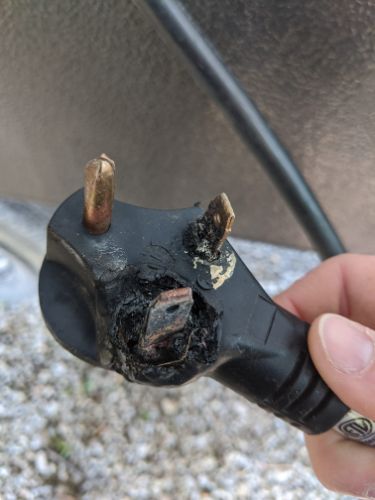
All RVers need a surge protector or EMS (Electric Management System). No ifs, ands, or buts.
All it takes is one dilapidated campground site, one freak thunderstorm, one power grid brownout, and you’ll be spending thousands of dollars to repair major internal damage to your RV. Consider it cheap insurance.
You don’t need a surge protector if you’re just running your RV off 12V battery power. And you might not need one – although it never hurts! – if you’re running your rig off a generator. Most generators have voltage protection or regulation built in.
If you don’t believe my warning, just start reading through online RV owner forums. Shoot the breeze with some RV buddies. You’ll find out that everyone and his mother knows someone whose RV got fried from a lightning strike or campground brownout.
If only they had sacrificed a $200 surge protector rather than $3,000 worth of parts and labor … (sigh).
As one online commenter said, “You put a lock on your door; why not on your electric supply?”
What Are Common RV Electrical Problems?
Common electrical problems include:
- High voltage (above 132 volts)
- Low voltage “brownouts” (below 104 volts)
- Open neutral
- 120V system: Energized, shock hazard, open circuit
- 240V system: Energized, 240V applied to 120V circuits! DANGER
- Open hot (no power)
- Reverse polarity (miswired pedestal or subpanel)
- Open ground (shock hazard)
- High frequency (above 62.5 Hz)
- Low frequency (below 57 Hz)
- High current (excess of circuit rated amperage)
For more information about what causes grid power failures, check out this PDF from Supreme Electronics.
Your RV system is built to handle some of these problems.
Your circuit breakers and fuses, for instance, protect your wire and appliances against excess current and short circuits.
Some of these issues, like high frequency, are quite rare in the U.S. electrical grid.
Where surge protectors come into their own is voltage protection. Few RVs come equipped from the factory with over- or under-voltage protection. Yet it is an all-too-common problem.
What Problem Does a Surge Protector Solve?
Surge protectors can help shield your RV from the effects of grid voltage problems.
To be clear, surge protectors don’t regulate voltage (that’s what autoformers do).
Instead, they detect voltage conditions. They’re like a fancy on/off switch. If the conditions are safe, they allow power to flow. If they detect dangerous conditions, they shut it off.
There are three basic out-of-bound voltage conditions:
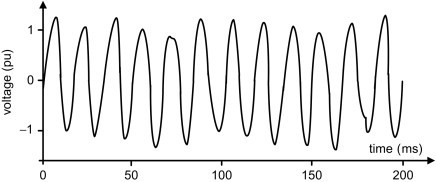
1) Spikes and Surges* (instantaneous super high voltage)
Tens of thousands of volts can course through a wire during a voltage spike or surge! Common causes include:
- Lightning storm strike
- Tree touching an uninsulated power line
- Car crashes into a power pole
- Abnormally large inductive loads
- Grid restarting after a power outage
Surges and spikes often cause blackouts, when the grid shuts down completely.
A nearby lightning strike can almost instantly skyrocket voltages far above safe limits, turning wires red hot and forcing electric arcs across terminals.
The damage is permanent. And fire could ignite if the arc occurs near flammable material.
So what I’m about to say is extremely important.
Basic surge protectors only guard against surges and spikes!
They don’t do willy-nilly for sustained high or low voltages, discussed below.
So a basic surge protector is sort of like catastrophic health insurance. It’s definitely not full coverage.
*If you’re a super nerd, you might care to know that there’s a technical difference between a voltage surge and a spike. A spike lasts three nanoseconds or less. Anything longer is a surge, and it’s the surges that do the most damage.
2) Voltage Rise
Technically, every time you flick on a lightbulb, you’re changing the supply voltage. But I’m not talking about those tiny dips and bumps.
I’m talking about sustained high voltages.
- Normal: 110-120V
- Acceptable: 120-125V
- Concerning: 125-132V
- Dangerous: 132+
High voltages are especially damaging to anything with a microprocessor, which includes your converter, refrigerator, microwave, air conditioner, furnace, heat pumps, etc.
There are two common causes of sustained high voltages:
- Poor adjustment/selection of grid transformer
- Open neutral in a 240V system*
*Let me hit on this 240V/open ground problem. Believe it or not, but sometimes a certified electrician is the one to blame.
In residential electricity, 30A almost always means 240V. And that NEMA L6-30P 240V plug looks pretty similar to that NEMA L5-30P 120V plug …
So a well-meaning electrician “just trying to help” in his/her spare time might assume that a 30A power pedestal should be wired for 240V power.
That’s wrong! In the RV world, only 50A service is wired for 240V!
Push 240V through a 120V system, and you’ll blow the control boards in every single appliance.
Which has happened to quite a few people.
Check your power, people!
3) Voltage Drop
Everyone talks about the lightning strikes, but I suspect low voltage kills more RVs than high voltage. It sneaks up on you. It overheats wires, melts insulation, and pits and chars contacts. Low voltage causes a load to draw more amps to maintain constant power.
- Normal: 110-120V
- Acceptable: 110-108V
- Concerning: 108-104V
- Dangerous: 104V-
Low-voltage situations cause “brownouts,” where the grid stays on but the voltage hovers dangerously low.
Some brownouts are planned events. When wildfires rage across Southern California, for instance, utilities often plan brownouts or rolling blackouts to reduce the strain on the grid.
Accidental brownouts can occur on a daily basis at older campgrounds. If it’s July 4th weekend and everyone’s running their air conditioner and microwave,* the voltage can easily plummet into hazardous ranges.
*Actually, this situation works both ways. If everyone decides to shut off their air conditioners at 7:59 p.m. to watch the fireworks at 8:00 p.m., that can induce a voltage surge large enough to fry your refrigerator control board!
But, Isn’t My Power Strip a Surge Protector?
Let’s get something straight right away. This 6-outlet power strip is NOT a true surge protector!
It might just be a power strip: Nothing more than a plastic box with some wires inside that multiplies one outlet into several.
Some models have a built-in circuit breaker, a simple thermal reset breaker that trips when the connected appliances draws too many amps.
These are NOT true surge protectors. They don’t guard against voltage fluctuations or continuous high or low voltages.
Some are designed to fry first in the case of a lightning strike, sacrificing themselves for the good of all appliances plugged into them. But it’s a gamble.
What’s the Difference Between a Circuit Breaker and a Surge Protector?
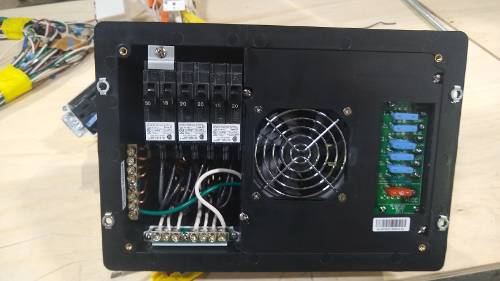
You peek into your converter. “But I already have circuit breakers!” you protest. “Why do I need a surge protector?”
A circuit breaker protects the wires in your RV camper from overheating – and maybe catching fire – due to excess current.
Small wire can only carry so much current. You can’t run an air conditioner, coffee maker, television, electric drill and space heater off a 14-gauge wire.
Excess current is measured in amps (A). Your typical RV has 15, 20, and 30-amp circuits at 120 nominal volts. As a rule, these wire sizes match these maximum amperage ratings:
- 15-amp circuits: 14-gauge wire
- 20-amp circuits: 12-gauge wire
- 30-amp circuits: 10-gauge wire
Wires 18 gauge and smaller are typically used for signal wire, like for thermostats, HDMI cables, and audio speakers.
However, a surge protector guards your wire and electronic equipment from voltage fluctuations. Unlike a circuit breaker, a surge guard doesn’t just disconnect power; it trys to dissipate it, first.
Voltage measures electromotive force. You can think of it as the electrical equivalent of pressure.
Without getting too technical, most RVs are designed with two electrical systems: One at 12V and one at 120V (a few have 240V, too). The 120V rating is the nominal voltage, but due to line losses and other factors, the voltage might actually be 119, or 115, or even 110, or so forth.
So most electronics are tested to operate at a certain range – say, 108 to 125 volts. They’re built with some leeway, some tolerance. But outside of those bounds, and the component can fail: Wires can overheat, arcs between contacts, etc.
After all, just imagine if you tried to use your garden hose as the hose on a fire truck. All that pressure would cause your garden hose to explode! Something similar happens with your electrical equipment.
That’s another reason why you need a surge protector!
Portable Vs. Hardwired RV Surge Protector
Portable Surge Protectors
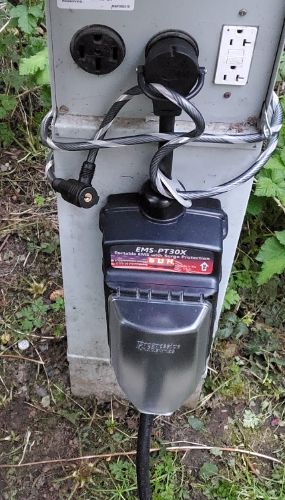
Portable units look like an extended pig tail or dog leg with a big, chunky block in the middle (the block is the actual surge protector).
You plug the dog leg into the campsite power pedestal, and then you plug your RV into the dogleg.
PROS –
Portable surge protectors for your camper are nice because they can be easily purchased, used, loaned, upgraded or replaced. They are rain-resistant and designed to be left outdoors in inclement weather.
Best of all, you can keep your $250 protector even if you sell or trade in your RV camper!
CONS –
However, portable electrical guards can be stolen. Most come with a security ring for use with a bike lock or padlock, but a dedicated thief could still take off with yours.
Also, they can be accidentally left at a campsite or forgotten at home.
Hardwired Surge Protectors
Hardwired units are thick, rectangular blocks. They are designed to be permanently installed inside your RV between the power inlet and distribution panel, either before or after a transfer switch (optional).*
*Most OEMs, like Progressive Industries, recommend installing an EMS surge protector before the transfer switch, arguing that it’s more important to protect the transfer switch from power supply problems rather than filtering the generator power supply, which normally has its own voltage regulation.
You cut the incoming power cable and land the stripped ends on the input terminals; then you land the other side of the power cable to the output terminals. See your manufacturer’s manual for more information.
It is recommended that an RV service technician or qualified electrician install a hardwired surge protector. You don’t want to mess it up!
Generally, the surge protector is installed in the same bay as the power inlet or the distribution panel. The component indicator lights or LCD screen should viewable by the RV owner or technician.
Thankfully, most hardwired units also come with remote digital displays.
Some hardwired EMS products come with bypass switches, allowing the RV owner to channel unregulated power through the system, except for one or two critical features, like voltage spike protection.
You might use the bypass feature if you’re willing to live with an ongoing power supply problem, like an open ground. I don’t recommend that, though. What’s the point of knowing you’re in danger and doing nothing anyway?
PROS –
Once installed, you can set it and forget it. There’s no setup or breakdown time. If you’re traveling extensively, those few minutes add up!
There’s also no risk of campground theft or damage from bad weather.
CONS –
These units are not weather-resistant. They need to be installed away from the elements, usually not in sealed compartments.
Installing and replacing the component does require more work upfront.
CONCLUSION
One type of surge protector is not better than the other. They both do an equally good job protecting your RV camper. Choose whichever type works best for your style of camping and traveling.
Personally, I think a portable product is best for most recreational RVers. If you’re a full-timer, invest in a hardwired unit.
Does Insurance Cover Damage from Power Surges?
Ah, liability, that four-letter word born of red tape. If your camper gets fried or burns to the ground because of a voltage surge, who’s responsible?
You? The campground owner? Your insurance policy? The manufacturer of the surge protector device? The regional power grid? The OEM RV manufacturer?
What if the cause is an Act of God like a lightning strike? Or what if it’s due to faulty wiring, like an open neutral? But what if you knew the power pedestal had an open neutral and you plugged in anyway? Did you sign a release of liability when you reserved the campsite?
I’m not an insurance claims adjuster. I don’t know the nitty-gritty. I can tell you, however, that these situations get messy. Everyone blames someone else. Your insurance company goes after the campground insurance provider, who blames the electric utility, who blames … you get the picture.
I can tell you with 95% certainty that neither your factory warranty nor aftermarket extended coverage will cover damage from electrical power failures.
Even if the damage, or some of it, is covered by your RV insurance contract, you’ll probably only receive the adjusted (i.e. depreciated) value. So that $250 LED TV, at two years old, may only fetch half its new retail price.
And unless you have “full-timer’s” insurance, most policies don’t cover personal belongings inside the coach or camper! Also, you generally need to pony up your deductible, first. Need I go on?
Insurance claims and civil suits are messy and laborious. Do yourself a favor. Rather than slogging through reams of red tape, get a surge protector, and save yourself the hassle. An ounce of prevention is worth a pound of cure!
What Are Some Recommended Features of an EMS?
Detection vs Management
Detection tells you something is wrong; management does something about it. Cheaper surge protectors may have an LCD screen or LED light indicating a fault or showing an error code, but they can’t do anything to stop the flow of electricity.
More advanced gizmos, however, can turn the power off and on to prevent potential damage or a fire.
An autoformer or voltage booster, both related cousins to the surge protector, can even boost low voltages to prevent a brownout effect!
Time-Delay Automatic Reset
Cheap surge protectors must be manually reset. You want an EMS with an automatic reset, that way you don’t have to crawl out of bed at night after a ground fault. But you don’t want your device to reset immediately!
As you probably know – and you certainly do if you’ve read my article about why you can’t run your air conditioner off battery! – A/C compressors draw a large amount of power up front. Quickly cycling a compressor off-and-on will drastically shorten its lifespan. In fact, cycling a compressor off and on every few seconds can break it within a minute.
Surge protectors with time-delay resets – usually around 2-3 minutes – protect your A/C compressor from over-cycling and burning out.
High Energy Dissipation
A surge protector can only dissipate so much energy before it fails. If it fails, better a $120 surge guard than a $2,000 inverter! Maximum energy dissipation is rated in joules. Bigger = better.
Just be aware that a direct or close-by lightning strike will likely fry your surge protector no matter what the joule rating.
You also want a fast response rate of three nanoseconds or less.
Remote Monitor/Bluetooth
Look, I don’t want to have to walk outside or peek underneath a cabinet every time I want an update on my electrical system. If you’re a frequent traveler, those minutes add up!
Premium hardwired units often come with remote LCD monitors. You mount the monitor where it’s accessible at eye level, and then you run a telecommunications cable from the hardwired unit to the monitor.
Some portable units offer Bluetooth capability, where you pair your smartphone or tablet with the surge protector. Then you can read the status data from anywhere inside your RV or campsite!
Amp Draw Monitor
It’s super helpful to know how many amps or watts you’re drawing at any given time. That’s valuable information you can use to figure out how long you can dry camp, how long you can run off battery, how to size a generator, or how many solar panels you need.
Lock Ring
When you leave your surge protector unattended, you need to lock it up with a chain padlock or cable bike lock! An integrated security ring with the body of the surge protector adds an extra layer of theft protection.
What Are the Best RV Surge Protectors?
Meet the Top Three OEM Brands!
Progressive Industries

Progressive Industries is one of the most trusted names in the surge protector market (not to be confused with Progressive Dynamics, an OEM converter and distribution panel manufacturer).
Progressive Industries is based in Menomonee Falls, Wisconsin. They manufacture both portable and hardwired units, along with NEMA power adapters, plugs, and a handful of other accessories.
The company is also well known for its customer support. You’ll find installation and user manuals, technical FAQs, forum questions and user-help videos. They also offer phone and email support.
Their products come with a Limited Lifetime Warranty. As I discussed in my FAQ about insurance about liability, however, Progressive Industries expressly denies any liability for – well, just about anything out of the ordinary. The warranty covers “defects in workmanship and materials.”
Progressive Industries sells two basic types of surge protectors: simple “Smart Surge Protectors” that just provide voltage surge protection, and advanced Energy Management Systems with a host of other features.
Southwire RV

Southwire is a major cable and wire manufacturer. Southwire RV is their Recreational Vehicles division specializing in surge protection and EMS.
As with Progressive Industries, Southwire offers a Limited Lifetime Warranty for their products. Neither one offers protection against direct lightning strikes, improper installation, and so forth.
Southwire also offers a Connected Equipment warranty. It’s a veritable War and Peace of fine print, though. They reserve the right to inspect the damaged equipment and the site of occurrence.
However, they may ask you to ship damaged equipment for inspection at your expense!
Southwire RV is known to offer decent customer service. You might have to jump through a few more hoops since it’s a larger company, though.
Southwire RV sells both basic surge protectors and EMS products under the Surge Guard brand name. Most of their products are portable plug-in-play, although they do sell three hardwire units as well.
Hughes Autoformers

Hughes is the industry leader for RV autoformers. They’ve been building the best o’ the best for 20 years, and their products are engineered in the Red, White and Blue.
But they also build some pretty darn good EMS surge protectors. In fact, they’re the only company that builds a replaceable surge module, which cuts down the cost of damage from voltage spikes.
Like the other two OEMs, they manufacture both simple surge protectors and advanced EMS systems, which are what I recommend.
Their units also include Bluetooth connectivity and a free smartphone/tablet app, so you can monitor your electrical system in real-time. One feature I love is the built-in watt meter, which gives invaluable power draw information for boondocking.
Hughes has developed a loyal following. The other two brands command more market share, but wherever Hughes goes, their loyal customers are sure to follow.
As I said, you should get an EMS. Don’t step over dollars to pick up pennies, alright? Buy once, cry once!
Here are the flagship portable plug n’ play surge protector EMS products from all companies: Progressive Industries, Southwire RV and Hughes Autoformers.
While similar, you’ll see a few differences. The Southwire units can handle a bigger voltage surge, for instance, but the Progressive products offer more restricted voltage control.
| EMS-PT30X | Surge Guard 34931 | Hughes PWD30-EPO | EMS-PT50X | Surge Guard 34951 | Hughes PWD50-EPO | |
|---|---|---|---|---|---|---|
| Brand | Pro. Ind. | Southwire RV | Hughes | Pro. Ind. | Southwire RV | Hughes |
| Price | $$$ | $$$ | $$$ | $$$ | $$$ | $$$ |
| Maximum Amp | 30A | 30A | 30A | 50A | 50A | 50A |
| Joules | 1790 | 2450 | 2400 | 3580 | 4200 | 4800 |
| Over/Under Voltage Protection | 104/132V @ 6s | 102/136V @ 7 s | 104/132V | 104/132V @ 6s | 102/136V @ 7 s | 104/132V |
| Frequency Protection | 51/69 Hz | 54/70 Hz | Unknown | 51/69 Hz | 54/70 Hz | Unknown |
| Built-in LCD Screen | Yes | Yes | No | Yes | Yes | No |
| Remote Monitor/Bluetooth | No | Yes/Opt. | Yes | No | Yes/Opt. | Yes |
| Reset Delay | 136 s | 128 s | 90s | 136 s | 128 s | 90s |
| Accidental 240V Protection | Yes | Yes | Yes | N/A | N/A | N/A |
| Bypass Switch | Yes | No | No | Yes | No | No |
| Amp Draw Shown | Yes | Yes | Yes | Yes | Yes | Yes |
| Compatible with Plug Adapters | Yes | Yes | Yes | Yes | Yes | Yes |
| Easy Pull Handle | Yes | Yes | Yes | Yes | Yes | Yes |
If you haven’t already purchased a surge protector, check out my recommendations for the top RV EMS surge protectors.
I only recommend all-in-one EMS guards from reputable companies. I’ve used a Progressive Industries model myself, have examined the Southwire RV units, and I know Hughes by professional reputation.
Leave a Reply